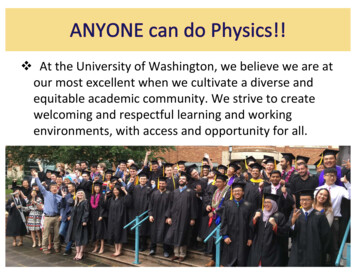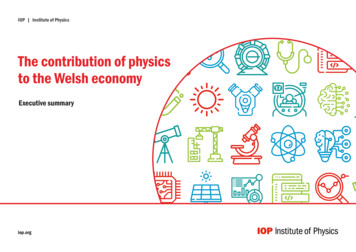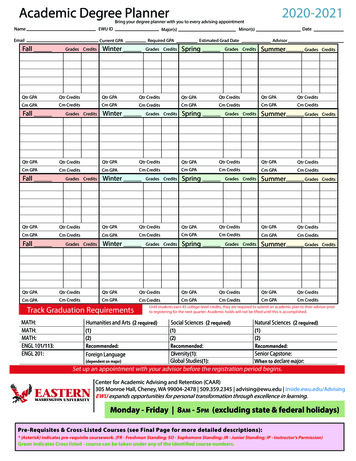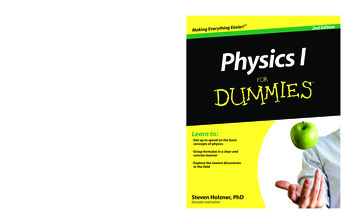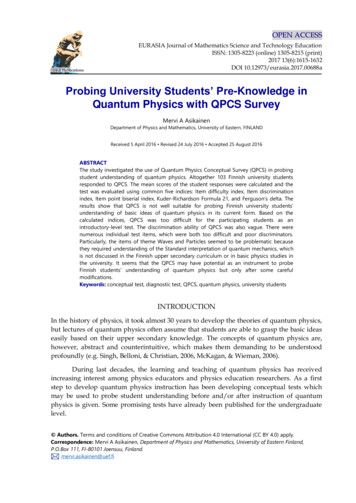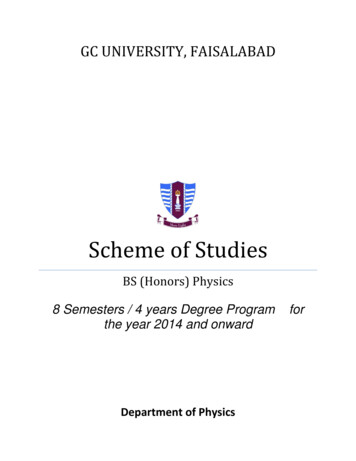
Transcription
GC UNIVERSITY, FAISALABADScheme of StudiesBS (Honors) Physics8 Semesters / 4 years Degree Programthe year 2014 and onwardDepartment of Physicsfor
Scheme of Studies BS PhysicsBS Physics program 2014 -2018 and OnwardsCourseCodesCourse TitleCreditHourSemester 1PHY-301Mechanics-I3 (3 – 0)PHY-303Waves & Oscillations3 (3 – 0)MTH-321Calculus-I3 (3 – 0)CSI-321Introduction to Computers3 (3 – 0)ISL-321Islamic Studies2 (2 – 0)ENG-321EAP (English for Academic Purposes)3 (3 – 0)Total17Semester 2PHY-302Mechanics-II3 (3 – 0)PHY-304Heat & Thermodynamics3 (3 – 0)PHY-306Introduction to Programming for Physicists3 (3 – 0)MTH-322Calculus-II3 (3 – 0)PST-322Pakistan Studies2 (2 – 0)ENG-322Reading, writing, speaking and listening skills3 (3 – 0)Total17PHY-401Semester 3Electricity & Magnetism-I3 (3 – 0)PHY-403Modern Physics-I3 (3 – 0)PHY-405Differential Equations-I3 (3 – 0)MTH-421Applied Mathematics3 (3 – 0)ENG-421Communication Skills3 (3 – 0)2GC University, Faisalabad
Scheme of Studies BS PhysicsPHY-407Lab Course-I (Mechanics, Heat and Vibrations)Total3 (0 – 3)18PHY-402Semester 4Electricity & Magnetism-II3 (3 – 0)PHY-404Modern Physics-II3 (3 – 0)PHY-406Differential Equations-II3 (3 – 0)PHY-408Lab Course-II (Optics & Modern Physics)3 (0 – 3)MTH-422Linear Algebra3 (3 – 0)CHM-402Chemistry (Special Topics)4 (3 – 1)Total19PHY-501Semester 5Methods of Mathematical Physics-I3 (3 – 0)PHY-503Classical Mechanics3 (3 – 0)PHY-505Electrodynamics-I3 (3 – 0)PHY-507Electronics-I3 (3 – 0)PHY-509Relativity and Cosmology3 (3 – 0)PHY-511Lab Course-III (Electromagnetism)3 (0 – 3)Total18PHY-502Semester 6Methods of Mathematical Physics-II3 (3 – 0)PHY-504Quantum Mechanics-I3 (3 – 0)PHY-506Nuclear Physics-I3 (3 – 0)PHY-508Electrodynamics-II3 (3 – 0)PHY-510Electronics-II3 (3 – 0)3GC University, Faisalabad
Scheme of Studies BS PhysicsPHY-512Lab Course-IV (Atomic & Nuclear Physics)Total3 (0 – 3)18Semester 7PHY-601Quantum Mechanics-II3 (3 – 0)ENG-601EFE (English for Employment)3 (3 - 0)PHY-603Nuclear Physics-II3 (3 – 0)PHY-605Solid State Physics-I3 (3 – 0)PHY-607Particle Physics-I*3 (3 – 0)PHY-609Advanced Electronics*3 (3 – 0)PHY-611Environmental Physics-I*3 (3 – 0)PHY-613Health and Medical Physics-I*3 (3 – 0)PHY-615Climatology and Metrology-I*3 (3 – 0)PHY-617Lab Course-V (Electronics)3 (0 – 3)Total18/15**Semester 8PHY-602Plasma Physics3 (3 – 0)PHY-604Computational Physics3 (3 – 0)PHY-606Solid State Physics-II3 (3 – 0)PHY-608Laser and Optics3 (3 – 0)PHY-610Statistical Mechanics3 (3 – 0)PHY-612Particle Physics-II*3 (3 – 0)PHY-614Advanced Electronics Lab Course*3 (3 – 0)PHY-616Environmental Physics Lab Course3 (3 – 0)PHY-618Health and Medical Physics -II*3 (3 – 0)4GC University, Faisalabad
Scheme of Studies BS PhysicsPHY-620Climatology and Metrology-II*3 (3 – 0)PHY-629Seminar1 (1 – 0)PHY-630Thesis**6 (0 - 6)PHY-631Project***3 (0 –3)Total19/22**Note:* One optional subject to be chosen in 7th and 8th semester.** Thesis will be allotted in the 7th semester. However, the credit hours for thesis will only counttowards the 8th semesters.*** Projects may be opted in lieu of option-II of the subject already taken by the student in 7thsemester. Internship will be offered to students during summer vacations as an optional activity.5GC University, Faisalabad
Scheme of Studies BS Physics1st SemesterPHY-301Mechanics-I3 (3 – 0)Vectors in 3-dimensions & fundamental operations, Stoke’s theorem, Gauss’s Divergence theorem, Dynamicsof Uniform circular motion, The Conical pendulum, The Rotor, The Banked curve, Equations of motion, Timedependent forces, Velocity-dependent forces, Non-Inertial frames & Pseudo forces, projectile motion, Workdone by constant & variable forces (one, & two dimension cases), K.E & the work-energy theorem, generalproof of work-energy theorem, power, conservative forces, P.E, one-dimensional conservative system, Two &many particle system, calculation of c.m. of different objects, Linear momentum of Particle & system ofparticles, conservation of linear momentum, system of variable mass, Rocket equation, collision, impulse andmomentum, Elastic and inelastic collisions in one dimension & two dimensions, centre of mass referenceframe.Recommended Books:Halliday, Resnick and Walker, 2011. Fundamental of Physics 9th Ed. John Wiley and Sons Inc, NewYork.2. Resnick, Halliday and Krane, 2002. Physics Vol. I, 5th Ed. John Wiley and Sons Inc, New York.3. Sears, Zemansky and Young, 2000. University Physics 8th Ed. Addison-Wesley, Reading (MA), USA.4. Alonso and Finn, 1999. Physics. Addison-Wesley, Reading (M.A), USAPHY-303Waves & Oscillations3 (3 – 0)1.S.H.M & its applications, Energy consideration in SHM, SHM & uniform circular motion, combinations ofHarmonic motion, Damped harmonic motion, Forced Oscillation & Resonance, Mechanical Waves, Travelingwaves, wave speed , wave equation, Power & intensity in wave motion, principle of superposition, standingwaves, Interference of waves, Beats, Doppler effect, visible light , speed of light in matter, double slitinterference, intensity in Double slit interference, adding waves using phasors, interference from thin film,Single slit diffraction, Intensity in single slit diffraction using phasors, diffraction at circular aperture,diffraction grating, x-ray Diffraction, Polarization by Reflection, & Double Refraction, Polarization states,Rotation of Plane Polarization.Recommended Books:Halliday, Resnick and Walker, 2011. Fundamental of Physics 9th Ed. John Wiley and Sons Inc, NewYork.2. Resnick, Halliday and Krane, 2002. Physics Vol. I, 5th Ed. John Wiley and Sons Inc, New York.3. Sears, Zemansky and Young, 2000. University Physics 8th Ed. Addison-Wesley, Reading (MA), USA.4. Alonso and Finn, 1999. Physics. Addison-Wesley, Reading (M.A), USAMTH-321Calculus-I3 (3 – 0)1.Number systems, bounded and unbounded sets, infimum and superimum, intervals, natural numbers, principleof induction, sequences, convergence, series and products, real valued functions, graphical representation ofreal valued functions. Limit of a function, properties of limit, continuity and discontinuity, differentiation,derivatives, higher derivatives, properties of differentiable functions exponential and logarithmic functions,trigonometric and inverse trigonometric functions, hyperbolic and inverse hyperbolic functions, maxima andminima, mean value theorems, intermediate forms, Taylor’s theorem, Macaroni’s series, power series. Planecurves, polar coordinates, tangents and normal, parabola, ellipse, hyperbola, vectors, equation of a straight line,scalar product, angle between two lines, equation of a plane, distance of appoint from a line, shortest distancebetween two lines.6GC University, Faisalabad
Scheme of Studies BS PhysicsRecommended Books:J.Stewart, 1999“Calculus”, Books/Cole Publishing Co. USA,.G.B. Thomas and R.L. Finney, 1996“Calculus and Analytic Geometry”,.Addison-Wesley PublishingCompany,3. E.W. Swokowski, M.Olinick, 1994. “Calculus” D.Pence, J.A. Cole, PWS Publishing Co. USA,CSI-321Introduction to Computers3 (3 – 0)1.2.Fundamentals of computer operation, analogue and digital basis of computer, hardware and software concepts,operating systems (DOS, Windows etc), Processing and storing data, network basics, database management,algorithm development, Introduction to a scientific language (FORTRAN, C etc) and lab work with M.SOffice, Origin and SPSS.Recommended Books: .1. Shelly, Cashman and Vermaat. 2003. “discovering Computers” Thomson Course technology2. R. Fairely. 1985, “Software Engineering Concepts”,McGraw-Hill.3. Diettel and Diettel. Prentice Hall, “Introduction to C ”, 3rd edition.4. Peter Norton. McGraw Hill International “Introduction to computers”,Edition, 6th editionISL-321Islamic Studies2 (2 – 0)Introduction to Quranic Studies, Basic Concepts of Quran, History of Quran, Uloom-Quran, Study of SelectedText of Holly Quran, Verses of Surah Al-Baqra Related to Faith(Verse No-284-286), Verses of Surah Al-HujratRelated to Adab Al-Nabi (Verse No-1-18), Verses of Surah Al-Mumanoon Related to Characteristics of faithful(Verse No-1-11), Verses of Surah al-Furqan Related to Social Ethics (Verse No.63-77), Verses of Surah AlInam Related to Ihkam(Verse No-152-154), Study of Sellected Text of Holly Quran, Verses of Surah Al-IhzabRelated to Adab al-Nabi (Verse No.6,21,40,56,57,58.), Verses of Surah Al-Hashar (18,19,20) Related tothinking, Day of Judgment, Verses of Surah Al-Saf Related to Tafakar,Tadabar (Verse No-1,14) , Seerat ofHoly Prophet (S.A.W) I, Life of Muhammad Bin Abdullah ( Before Prophet Hood), Life of Holy Prophet(S.A.W) in Makkah, Important Lessons Derived from the life of Holy Prophet in Makkah, Seerat of HolyProphet (S.A.W) II, Life of Holy Prophet (S.A.W) in Madina, Important Events of Life Holy Prophet inMadina, Important Lessons Derived from the life of Holy Prophet in Madina, Introduction To Sunnah, BasicConcepts of Hadith, History of Hadith, Kinds of Hadith, Uloom –ul-Hadith, Sunnah & Hadith, Legal Positionof Sunnah, Selected Study from Text of Hadith, Introduction To Islamic Law & Jurisprudence, Basic Conceptsof Islamic Law & Jurisprudence, History & Importance of Islamic Law & Jurisprudence, Sources of IslamicLaw & Jurisprudence, Nature of Differences in Islamic Law, Islam and Sectarianism , Islamic Culture &Civilization, Basic Concepts of Islamic Culture & Civilization, Historical Development of Islamic Culture &Civilization, Characteristics of Islamic Culture & Civilization, Islamic Culture & Civilization andContemporary Issues, Islam & Science, Basic Concepts of Islam & Science, Contributions of Muslims in theDevelopment of Science, Quranic & Science, Islamic Economic System, Basic Concepts of Islamic EconomicSystem, Means of Distribution of wealth in Islamic Economics, Islamic Concept of Riba, Islamic Ways ofTrade & Commerce, Political System of Islam, Basic Concepts of Islamic Political System, Islamic Concept ofSovereignty, Basic Institutions of Govt. in Islam, Islamic History, Period of Khlaft-E-Rashida, Period ofUmmayyads, Period of Abbasids, Social System of Islam, Basic Concepts Of Social System Of Islam,Elements Of Family, Ethical Values Of IslamRecommended Books:1.2.3.4.Dr. Muhammad Zia-ul-Haq, “Introduction to Al Sharia Al Islamia” Allama Iqbal Open University,Islamabad (2001)Ahmad Hasan, “Principles of Islamic Jurisprudence” Islamic Research Institute, International IslamicUniversity, Islamabad (1993)H.S. Bhatia, “Studies in Islamic Law, Religion and Society” Deep & Deep Publications New Delhi(1989)Mir Waliullah, “Muslim Jrisprudence and the Quranic Law of Crimes” Islamic Book Service (1982)7GC University, Faisalabad
Scheme of Studies BS PhysicsHameed ullah Muhammad, “Emergence of Islam”, IRI, IslamabadHameed ullah Muhammad, “Muslim Conduct of State”Hameed ullah Muhammad, ‘Introduction to IslamMulana Muhammad Yousaf Islahi,”Hussain Hamid Hassan, “An Introduction to the Study of Islamic Law” leaf Publication Islamabad,Pakistan.ENG-321EAP (English for Academic Purposes)3 (3 – 0)5.6.7.8.9. Introducing ourselves Describing things Getting and giving information Recounting past events Talking about facts and opinions Agreeing and disagreeing Compare and Contrast Cause and effect Using your imagination Reporting Writing Essays Presentation skills Assessment2nd SemesterPHY-302Mechanics-II3 (3 – 0)Rotational dynamics, Relation between Linear & angular variables, K.E of Rotation & Rotational Inertia ofSolid bodies, Torque acting on a particle, Parallel & Perpendicular axes theorem, combined Rotational &translational motion, rolling without slipping, Angular momentum of a Particle & system of Particles, Relationbetween torque & angular momentum. Conservation of angular momentum, spinning top, stability of spinningobjects, Newton’s law of universal gravitation, gravitational effects of spherical distribution of matter,gravitational P.E, Gravitational field & Potential, Motion of planets & satellites, Kepler’s laws, Energyconsideration in planetary & satellite motion, Bulk Properties of matter, Hook’s Law , Types of elasticity,variation of pressure in earth’s atmosphere, surface tension, general concepts of fluid flow, Bernoulli’sequations, viscosity, Poiseuille’s law.Recommended Books:1.2.3.Halliday, Resnick and Walker, 2011. Fundamental of Physics 9th Ed. John Wiley and Sons Inc, NewYork.Resnick, Halliday and Krane, 2002. Physics Vol. I & II, 5th Ed. John Wiley and Sons Inc, New York.Sears, Zemansky and Young, 2000. University Physics 8th Ed. Addison-Wesley, Reading (MA), USA.8GC University, Faisalabad
Scheme of Studies BS Physics4. Alonso and Finn, 1999. Physics. Addison-Wesley, Reading (M.A), USA.PHY-304Heat & Thermodynamics3 (3 – 0)Macroscopic properties of a gas and the ideal gas law, The ideal gas model, Kinetic calculations of pressure,Kinetic interpretation of the temperature, Work done on an ideal gas, The internal energy of an ideal gas,intermolecular forces, Statistical distributions and the mean values, Mean free path, The distribution ofmolecular speeds, The distribution of energies, The internal energy of an ideal gas, Brownian motion, Heat, Themechanical equivalent of heat, Heat capacity and specific heat, Heat of transformation, Heat capacities ofsolids, Heat capacities of an ideal gas, The first law of thermodynamics, Applications of the first law, Thetransfer of heat, Reversible and irreversible process, Heat engines and the second law, Refrigerators and thesecond law, The Carnot cycle, Carnot’s theorem and the second law, The thermodynamic temperature scale,Entropy: Reversible process, Entropy : Irreversible Process, Entropy and the second law, Zeroth law, ,Maxwell’s thermodynamics relations, TDS equations, Clapeyron’s equation, entropy and second law ofthermodynamics, temperature scale, entropy, low temperature physics. Thermoelectricity, Seabeck effect,Peltier effect, thermocouple.Recommended Books:Halliday, Resnick and Walker, 2011. Fundamental of Physics 9th Ed. John Wiley and Sons Inc, NewYork.2. Resnick, Halliday and Krane, 2002. Physics Vol. I & II, 5th Ed. John Wiley and Sons Inc, New York.3. Sears, Zemansky and Young, 2000. University Physics 8th Ed. Addison-Wesley, Reading (MA), USA.4. Alonso and Finn, 1999. Physics. Addison-Wesley, Reading (M.A), USA.PHY-306Introduction to Programming for Physicists3 (3 – 0)1.Introduction to programming, Significance of computers in the present physical sciences scenario, Software andhardware domains, Scientific computing, high and low level languages, flow charts, scientific programminglanguages, C/C and other scientific Programming language: memory management in C , structure of C program, Generic form, Header files, Constants, Local variables, Input/output statements, Simple program,Variables, Data types, variables, Operators, Loops, Break, Continue, If and if-else statements, Conditionaloperator, Switch statement, Flags and conditional testing, One-dimensional arrays, Multi-dimensional arrays,String manipulation functions, Arrays as lists, Sorting, Searching, functions, built-in and user defined functions,file system, pointer, inheritance, polymorphism, C for scientific programming. Lab work.Recommended Books:1. Deitel H M and P J Deitel, 2012, C How to Program, 8/e, Early Objects Version, Prentice Hall2. Robert Lafore , 2002, Object-oriented Programming in C , Ed. 4th, SAMS publishers.3. Robert L, TURBO C , 1991, Waite Group.4. Harrison S P and G Steele Jr. 1987, C: A Reference Manual, Prentice-Hall.5. Peter Norton, Introduction to computers, 6th Ed., McGraw Hill International Edition.MTH-322Calculus-II3 (3 – 0)Riemann integrals and their applications, fundamental theorems of calculus, area under the curve, integration ofrational, irrational, trigonometric, exponential and logarithmic functions, improper integrals, beta and gammaintegrals. Real functions of several variables, directional derivatives, partial derivatives, local maxima andminima, gradient, chain rule, stationery points, mean value theorems, total differentials, implicit functions,curve tracing, tangents, one parameter family of curves, envelops of a family of curves. Volumes of solids ofrevolution, area of a surface of revolution, moments and center of gravity, multiple integrals and applications,infinite series, test for its convergence, root and ratio tests, Gauss and integral tests.Recommended Books:1.J.Stewart, 1999“Calculus”, Books/Cole Publishing Co. USA,.9GC University, Faisalabad
Scheme of Studies BS PhysicsG.B. Thomas and R.L. Finney, 1996“Calculus and Analytic Geometry”,.Addison-Wesley PublishingCompany,3. E.W. Swokowski, M.Olinick, 1994. “Calculus” D.Pence, J.A. Cole, PWS Publishing Co. USA,PST-322Pakistan Studies2 (2 – 0)2.Historical Perspective, Ideological rationale with special reference to Sir Syed Ahmed Khan, AllamaMuhammad Iqbal and Quaid-i-Azam Muhammad Ali Jinnah, Factors leading to Muslim separatism, People andLand, Indus Civilization, Muslim advent, Location and geo-physical features, Government and Politics inPakistan, Political and constitutional phases, 1947-58, 1958-71, 1971-77, 1977-88, 1988-99, 1999 onward,Contemporary Pakistan, Economic institutions and issues, Society and social structure, Ethnicity, Foreignpolicy of Pakistan and challenges, Futuristic outlook of Pakistan.Recommended Books1. Akbar, S. Zaidi. 2000. Issue in Pakistan’s Economy. Karachi: Oxford University Press2. Afzal, M. Rafique. 1998.Political Parties in Pakistan, Vol. I, II & III. Islamabad: National Institute ofHistorical and cultural Research3. Mehmood, Safdar. 1994. Pakistan Political Roots & Development. Lahore,4. S.M. Burke and Lawrence Ziring.1993 Pakistan’s Foreign policy: An Historical analysis. Karachi:Oxford University Press,.5. Haq, Noor ul. Making of Pakistan: 1993. The Military Perspective. Islamabad: National Commissionon Historical and Cultural Research,6. Muhammad Waseem, 1987 Pakistan Under Martial Law, Lahore: Vanguard7. Burki, Shahid Javed. 1980 State & Society in Pakistan, The Macmillan Press Ltd.8. Ziring, Lawrence. 1980 Enigma of Political Development. Kent England: WmDawson & sons Ltd,.9. Zahid, Ansar. 1980. History & Culture of Sindh. Karachi: Royal Book Company10. Aziz, K.K. Party, 1976. Politics in Pakistan, Islamabad: National Commission on Historical andCultural Research,11. Wilcox, Wayne.The Emergence of Banglades., Washington: American Enterprise, Institute of PublicPolicy Research, 1972.12. Mehmood, Safdar. Pakistan Kayyun Toota, Lahore: Idara-e-Saqafat-e-Islamia, Club Road, nd.13. Amin, Tahir. Ethno - National Movement in Pakistan, Islamabad: Institute of Policy Studies,Islamabad.14. Sayeed, Khalid Bin. 1967. The Political System of Pakistan. Boston: Houghton Mifflin,ENG-323Reading, writing, speaking and listening skills3 (3 – 0)To be provided by the concerned Department3rd SemesterPHY-401Electricity & Magnetism-I3 (3 – 0)Electric charge, coulombs law, Electric field, continuous charge distributions, image charges, electric dipole,Gauss’s Law and its applications, electric potential, electric properties of materials, capacitor, dielectric,capacitors in circuits, energy stored in capacitors, electric polarization, Gauss’s Law for dielectrics, electriccurrent, current density and Ohm’s law, equation of continuity, DC circuits, analysis of circuits, electric fieldsin circuits, resistance in circuits, energy transfers in a circuit, RC circuits, magnetism, magnetic force on acharged particle, magnetic torque due to currents, magnetic dipole, Biot-Savart Law and its applications,Ampere’s law and its applications, Gauss’ law for magnetism, origin of atomic and nuclear magnetism,magnetization, magnetic materials: diamagnetic, paramagnetic, ferroamagnetic. Induced magnetic fields anddisplacement current.10GC University, Faisalabad
Scheme of Studies BS PhysicsRecommended Books:Halliday, Resnick and Walker, 2011. Fundamental of Physics, 9th Ed , John Wiley and Sons Inc, NewYork,.2. Griffiths D, 2003, Introduction to Electrodynamics, Prentice Hall.3. Resnick, Hlliday and Krane, 2002, Physics Vol II, Ed. 5th, John Wiley and Sons Inc, New York.4. Sears, Zemansky and Young, 2000, University Physics Ed. 11th, Addison-Wesley, reading (MA),USA.PHY-403Modern Physics-I3 (3 – 0)1.1. Halliday, Resnick and Walker, 2011. Fundamental of Physics, 9th Ed , John Wiley and Sons Inc, NewYork,.2. Raymond A. Serway and John W. Jewett, January 11, 2010, 8th Edition, Physics for Scientists andEngineers with Modern Physics.3. Demtroder. W, 2005. Atoms, Molecules and Photons, publisher: Springer4. Foot C.J., 2005. Atomic Physics 1st Ed, Oxford University Press5. H. Haken and H.C. 2004, The Physics of Atoms and Quanta, 7th Ed, Wolf, publisher: Springer6. Bransden B.H, and Joachain 2003. Atoms and Molecules 2nd Ed. publisher: Pearson Education.7. Beiser, A 2002, Concepts of Modern Physics. 6th Ed. McGraw-Hill, USA.8. Halliday Resnick, and Krane, 2002. Physics Vol. II, 5th Ed, John Wiley and Sons Inc, New YorkPHY-405Differential Equations-I3 (3 – 0)Introduction to differential equations, Definitions and terminology, Initial-value problems, Linear and nonlinearequations, general solution, Particular solution, explicit solution, implicit solution, Differential equations asmathematical models. First order differential equation, Solution curves without the solution, Separablevariables, linear differential equations, exact equations, Solution by substitution. Modeling with first orderdifferential equations, linear differential equations, and Non-linear equations, Systems of linear and non-linearequations. Higher-order differential equations, Preliminary theory, linear equations, initial-value and Boundaryvalue problems, homogeneous equations, non-homogeneous equations, Reduction of order, homogeneous linearequations with constant coefficients, Undetermined coefficients (Superposition approach, Annihilatorapproach), Variation of parameters, Cauchy-Euler equations, Solving systems of linear equations byelimination, nonlinear equations Bernoulli’s equation, first order non-linear ordinary differential equation,Clairaut’s equation, Riccati equation, higher order exact linear equationsRecommended Books:E.Kreyszig, Wiley, , 1999. “Advanced Engineering Mathematics”, New YorkK.F. Riley, M.P. Hobson and S.J. Bence, 1997. “Mathematical Methods for Physics and Engineering”,Cambridge University Press,3. G.B Arfken and H.J Weber,1995, “Mathematical Methods for Physicists”, A press, New York,.4. S.J Farlow, McGraw-Hill, 1994. “An Introduction to Differential Equations and their Applications”,MTH-421Applied Mathematics3 (3 – 0)1.2.Basic concepts of statistics, concept of probability, axioms of probability, discrete probability, & continuousprobability, frequencies and probabilities, binomial, Poisson, and normal distributions, mode, mean, median,regression and correlation, sampling theory, analysis of variance. Numerical Analysis, solutions of algebraicand transcendental equations, roots of cubic and biquadratic equations, numerical methods, bisection methods,Newton-Raphson, formula, the secant method, method of false position, numerical solution of simultaneouslinear algebraic equations, Gauss elimination method, Cramer’s rule, Choleski’s factorization method, Jacobiiterative method, numerical integration, rectangular rule, Trapezoidal rule, Simpson’s rule, Error analysis.Recommended Books:1.F. Riley, M. P. Hobson and S. J. Bence, 1997. “Mathematical Methods for Physics and Engineering”Cambridge University Press,11GC University, Faisalabad
Scheme of Studies BS PhysicsG. Arfken and H. J. Weber, 1995. “Mathematical Methods for Physicists” Academic Press,E. Butkov, Addison-Wesley1968, “Mathematical Physics” Publishing Company,.“Experimental Measurements” by Precision, Error and Truth by N. C. Barford, Addison-WesleyPublishing Company, Inc.5. “Modern Statistics” by Richard Goodman, ARC Books, NY.ENG-421Communication Skills3 (3 – 0)2.3.4.To be provided by the concerned DepartmentPHY-407Lab Course-I (Mechanics, Heat and Vibrations)3 (0 – 3)Measurement of Oscillation period of the pendulum as a function of the angle of oscillation Φ of theoscillation plane for two different pendulum lengths.2. Projectile motion: (a) To determine the range as a function of the angle of inclination. (b) Todetermine the maximum height of projectile as a function of angle of inclination. (c) To determine therange / height as a function of initial velocity of projectile.3. To determine the value of ‘g’ be compound pendulum (Kater’s Pendulum).4. To determine Horizontal/Vertical distance by Sextant.5. To determine the frequency of A.C supply by Melde’s experiment.6. To determine the modulus of rigidity of a flat spiral spring.7. To determine the modulus of rigidity of a wire by solid cylindrical rod.8. Surface tension of water by capillary flow method.Recommended Books:1. Kraftmakers, Y. 2007. Experiments and demonstrations in Physics, World Scientific Publishing Co.Ltd.2. Isenberg, C. 1996. Physics Experiments and Projects for students (Physics experiments & Projects).Taylor and Francis, USA.1.4th SemesterPHY-402Electricity & Magnetism-II3 (3 – 0)Faraday’s Law of Electromagnetic induction, review of emf, Lenz’s Law, Induced electric fields,Inductance, Inductance of a Solenoid and Toroid. Transients, LR Circuits, Growth and Decay of current,Energy stored in a magnetic field, Energy density, Electromagnetic Oscillation, Qualitative andQuantitative analysis, Forced electromagnetic oscillations and resonance, Alternating current, AC currentin resistive, inductive and capacitive elements, single loop RLC circuit, acceptor and rejecter circuits,Power in A.C circuits, Summarizing the electro-magnetic equations, Induced magnetic fields &displacement current, Maxwell's equations, Maxwell equations in a medium, dielectrics and magneticmaterials, e.m spectrum, generating an electro-magnetic wave, Traveling waves and Maxwell's equations,energy transport and the Poynting Vector, Propagation of electromagnetic waves in conducting media andin ionized gases, reflection and transmission at normal and oblique incidence, absorption and dispersion ofelectromagnetic waves in a conductor.Recommended Books:1.2.3.Serway, Raymond A. and Jerry S. Faughn, 2003, College physics, 6th ed, Brooks/Cole PublishinResnick, Hlliday and Krane. 2002, Physics, Vol II, 5th Ed. John Wiley and Sons Inc, New YorkFeynman R.P, R.B Leighton and M.Sands. The Fyenman Lectures of Physics; Electromagnetism andmatter. Addison Wesley.4. Griffiths D. 1989, Introduction to Electrodynamics. Prentice Hall.5. Lorrain P and D.Corson. Electromagnetic Fields and Waves, 2nd Ed. Freeman publications.PHY-404Modern Physics-II3 (3 – 0)12GC University, Faisalabad
Scheme of Studies BS PhysicsReview of Bohr’s theory, Summerfeld model, Frank Hertz Experiment, Stern Gerlach Experiment, quantumnumbers, radiactive transition, selection rules, Zeeman Effect (normal and anomalous Zeeman Effect, The StarkEffect, Pauli exclusion principle, Spin orbit coupling LS coupling, JJ coupling, X-ray spectra. Molecularspectra, Ionic and covalent bonding, diatomic molecular-rotational, vibrational and electronic spectra,polyatomic molecules, black body radiation, Einstein co-efficient (A and B coefficients) and stimulatedemission, pumping schemes, characteristics of laser, different types of lasers, laser applications. The finestructure of hydrogen, Helium, the ground state of helium, excited states of helium, transitions in helium.Recommended Books:1. Halliday Resnick, and Walker, 2011. Fundamental of Physics, 9th Ed , John Wiley and Sons Inc, NewYork,.2. Demtroder. W, 2005. Atoms, Molecules and Photons, publisher: Springer3. Foot C J. 2005, Atomic Physics 1st Ed, Oxford University Press.4. Haken H and H.C. 2004, The Physics of Atoms and Quanta, 7th Ed, Wolf, publisher: Springer5. Beiser, A 2002, Concepts of Modern Physics. 6th Ed. McGraw-Hill, USA.6. Bransden B H, and Joachain 2003. Atoms and Molecules 2nd Ed. publisher: Pearson Education.7. Halliday Resnick, and Krane, 2002. Physics Vol. II, 5th Ed, John Wiley and Sons Inc, New YorkPHY-406Differential Equations-II3 (3 – 0)Modeling with higher order equations, Linear equations, initial-value problems, Spring/Mass systems (Freeundamped motion, Free damped motion and driven motion), Resonance and Beats Series Circuit (RC seriescircuit, LC series circuit, RL series circuit and RLC series circuit), linear equations: boundary value problems,non-linear equations, Series Solutions, Series solutions about ordinary points, Review of Power series, Powerseries solution, solution about singular points, Method of Frobenius Series solutions, Legendre’s equation,Bessel’s equations, Bessel function of the first kind, Bessel’s function of second kinds, Parametric Bessel’sequation, Differential recurrence relations, spherical Bessel’s function, Legendre Polynomials, Recurrencerelations, Laplace transform, Definition of the Laplace transform, Inverse transforms, Transforms ofderivatives, Translation Theorems (translation on the s-axis and t-axis), Additional operational properties,Transforms of an integrals and a periodic functions, Dirac Delta function, Laplace transform of a Dirac Deltafunction, Applications to differential equations and systems of linear differential equations, Systems of linearfirst order differential equations, Preliminary theory, Homogeneous systems with constant coefficients, DistinctReal eigenvalues, repeated eigenvalues, Complex eigenvalues, undetermined coefficients, Variation ofparameters, Matrix exponentialRecommended Books:E.Kreyszig, Wiley,1999.“Advanced Engineering Mathematics” New York,K.F. Riley, M.P. Hobson and S.J Bence,1997 “Mathematical Methods for Physics andEngineering”,Cambridge University press.3. G.B Arfken and H.J 1995, “Mathematical Methods for Physicists”, Weber A Press, New York, .PHY-408Lab Course-II (Optics & Modern Physics)3 (0 – 3)1.2.1. Characteristic x-rays of Molybdenum2. Specific rotation
Scheme of Studies BS Physics 2 GC University, Faisalabad BS Physics program 2014 -2018 and Onwards Course Codes Course Title Credit Hour Semester 1 PHY-301 Mechanics-I 3 (3 - 0) PHY-303 Waves & Oscillations 3 (3 - 0) MTH-321 Calculus-I 3 (3 - 0) CSI-321 Introduction to Computers 3 (3 - 0) ISL-321 Islamic Studies 2 (2 - 0)

